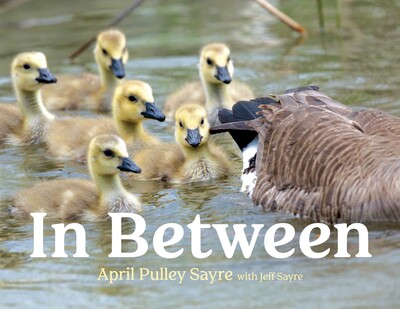I’m always on the hunt for books that capture a universal experience in a way that opens possibilities for writing in response (or in conversation). Mentor texts that invite writers to riff off their brilliance while creating something entirely new.
April Pulley Sayre’s latest picture book, In Between, is exactly that kind of book (Beach Lane Books, 2023).
Sayre combines nature photos with lyrical text, and if you’re not familiar with her work, I highly recommend her beautiful books. In In Between, she begins with the literal “in between” of animals being: “In between boulders. In between branches. In between blueberry rows. In between inside and outside, day and night.”
With one skillfully shifting line (“In between holding tight and letting go”), Sayre delves into more playful (and conceptual) territory with what it means to be in between.
“Awkward, unsteady, in between fills up with not yet, no longer, almost. Almost landed, but not yet. Almost asleep, but not yet. Almost ready, but not yet living on one’s own.”
She opens the door to such rich possibilities for thinking and conversation, especially for an audience that is continuously experiencing transitions. The visuals in this book might be animals, but child readers will see themselves reflected in these pages.
Sayre offers hope and opportunity in the face of what can feel scary and uncertain.
Depending on where you live, the month of May might be “in between” the current school year and the beginning of summer break. This is true for me in Colorado, and it does feel as if we are in a transitional time—still feeling a sense of urgency to finish this year strong while also looking forward to a nice, long break.
For kids, summer is an in between. Can I say I’m a first grader if I’ve finished kindergarten but first grade has not yet begun? I remember having this very conversation with my niece years ago. (She was insistent that she could not.)
In Between is the kind of mentor text that serves purposes on multiple levels. It’s an entry point into conversation about what it feels like to experience a transition—at the most literal level, saying goodbye to one classroom community and anticipating the next. Timely, in May and June.
It’s also an opportunity to think metaphorically, to flex those conceptual thinking muscles by recognizing that there are many types of transitions. It’s an opportunity to build community through sharing and connecting those experiences.
There are so many possibilities for “in between” that kids might name and be inspired to write about.
There is the in between of a lost tooth—the tender, empty space a reminder that the new tooth has not yet grown in.
There is the in between of traveling—no longer at home, but not yet at your destination.
There is the in between of waiting for a new sibling to be born. Not yet a big brother or sister, but aware a world-rocking change is coming.
Kids might find themselves
in between books
in between meals
in between best friends.
There are times kids are
in between holidays
in between shoe sizes
in between favorite toys.
There are so many moments when kids might recognize that they have outgrown one thing without fully growing into another.
Those moments when it’s time to take on a new challenge, but they’re not yet sure that they’re ready.
Waiting. Worrying. Anticipating. These universal feelings connect us.
I can imagine reading this book aloud, studying it closely for Sayre’s craft moves. I can hear students talking about all the connections they can make to the idea of being “in between.”
Depending on the grade level, this might turn into a class book, with the youngest writers contributing one page (with spectacular artwork!): in between tadpole and frog, in between the rain and the sunshine, in between bedtime and my birthday.
For older writers, they might choose an in between to elaborate on—perhaps in the form of poetry or through a combination of words and images (like Sayre does). Perhaps they’ll opt to incorporate photos of themselves. . .
I can imagine such divergent pieces emerging from this kind of exercise. And near the end of the year, when units of study are wrapping up and teachers are seeking authentic writing experiences for kids, I love the way books like this one offer real reasons to keep writing. Real reasons for communities to continue getting to know each other better.
In Between is a mentor text to be mined for writing ideas—a chance to both think aloud with kids about how we do this and to offer them practice at this important skill. How do writers find inspiration in the writing of others? How do we use that spark to fuel our own play as writers? How does it help us as writers to do this?
[For me this week: In between ideation and finished blog post was the stack of books in the backseat of my car, waiting to be read.]



I was so inspired by your ideas that I already went and purchased this book. What a fantastic blog post. I will definitely try this with my students this year!!
LikeLiked by 1 person
Thanks for the introduction to April and her books! They look amazing and I have never come across any of them before, yet there are so many. Thanks too for all the great ‘in between’ suggestions based on her book.
LikeLiked by 1 person